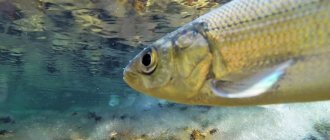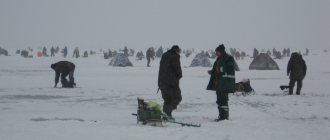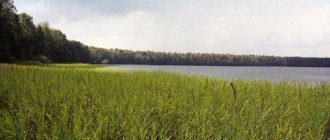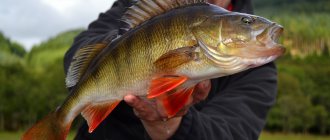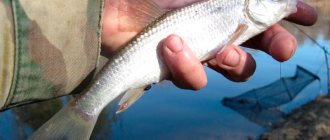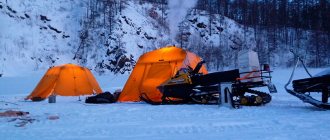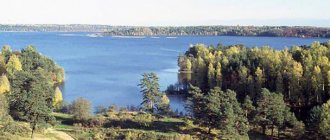Neva - this is a Russian river, which is the decoration of St. Petersburg and allows you to enjoy both winter and summer fishing: local residents prefer not to go on long journeys, but to engage in urban fishing. Its waters are home to a variety of fish species, so to get a catch you will need to understand their behavior and fishing methods.
What kind of fish is found in the Neva?
Various fish live in the waters of the Neva; the following species are most often caught:
- Pike is one of the most popular predators, caught by local fishermen. To find trophy specimens, you most often have to go outside the city limits, but medium-sized pike also bite in St. Petersburg.
- Pike perch is also popular due to the number of ways to catch it; for these purposes you can use donks, spinning rods, girders and even ordinary float rods.
- Perch is the most common prey, since large populations live in the Neva, and even novice fishermen can easily cope with catching this predator.
- Roach is also popular among fishermen because it lives in large numbers in the Neva, and the fishing process is simple.
- Bream is also found in large numbers; it bites equally well both in the city and in the Leningrad region.
- White bream is sometimes caught during urban fishing, but the chances of catching it are low; This fish bites much better in the Leningrad region.
- Ide has tasty meat, but few fishermen go for it; It is usually caught randomly when fishing for pike or perch. The bite persists throughout the year, but it is stable only from May to June and from August to September.
- Rudd is often confused with roach; the main distinguishing feature is its weight - it can reach up to 1.5-2 kg.
- Asp is a desirable catch for fishermen, but it is not often possible to catch it in the Neva; For this fish it is better to go outside the city. It is necessary to remember that this is not only a cautious and timid fish, but also a strong fish, so it is important to be able to both interest it with a properly selected bait and not scare it away, and to pull it ashore.
- Chub is also a strong fish, but it is easier to catch than asp. For these purposes, you can use float rods, but to fish for large specimens you will need to arm yourself with spinning rods. Chub are caught from city embankments or from swimming craft; this fish is common not only in the Neva, but also in many fast-flowing rivers of the Leningrad region.
- Chekhon is one of the varieties of commercial fish in St. Petersburg and the Leningrad region. It is small in size and moves in schools, so if you choose the right place for fishing, there are no problems with bites.
- Whitefish is found in the Neva and most of its tributaries, but catching this fish is difficult for anglers due to the lack of permanent habitat and frequent migrations.
- Trout is a valuable prey, but the chance of catching it in the Neva appears only in the autumn season, when it enters the river from Lake Ladoga and Onega.
- Rotan is a popular catch for amateurs and beginners, since it is not picky when choosing food and bites on any bait. The spread of this fish is undesirable because it negatively affects the habitat, but in St. Petersburg and the Leningrad region you can find areas of the Neva with large populations of rotan.
- Burbot is a popular catch in the off-season, when other fish have an unstable bite. This is an unpretentious breed that is not afraid of humans, so fishing is quite simple.
- Catfish is the largest fish that can be found in St. Petersburg and throughout the Leningrad region. To catch it, it is better to go to Lake Peipsi, since a small number of catfish live in the Neva, although the likelihood of a bite increases if you go fishing at night.
- The eel lives in lakes, but sometimes it passes through the Neva: during such periods you can count on catching the narrow-headed and blunt-nosed varieties.
- Smelt is found in the Neva only during the spawning period; the rest of the time it is in the lakes.
Other species found in the Neva include sturgeon, lamprey, gudgeon, ruffe and salmon.
Bridges over the Neva
Peter the Great forbade the construction of bridges, because he believed that all his subjects should learn maritime craft. But after his death, in 1727, the floating St. Isaac's Bridge was built. At night it was taken aside for the passage of ships. This bridge solved the crossing problem only partially. The bridge was built only in the summer, and in the winter the townspeople moved from one bank to the other on the ice.
A permanent connection between Vasilievsky Island and the city appeared only in 1850 with the construction of the Blagoveshchensky Bridge, the first permanent bridge in St. Petersburg. Isaac's Bridge lost its transport significance, and after the fire of 1916 it was dismantled.
author: Dmitry Kazakov
Monument on the site of the first floating bridge in St. Petersburg
The Petrograd side was also cut off from the center of the Northern capital for a very long period, despite the fact that the history of the city began there. Industrial enterprises were located on Petrogradka, and active residential construction began only at the beginning of the 20th century after the construction of the Trinity Bridge.
A permanent crossing between the Okhta district and the center of St. Petersburg appeared only in 1811, when the Emperor Peter the Great Bridge (now Bolsheokhtinsky) was built.
Not many people know that the Palace Bridge, which is located in the very center of the city near the Hermitage, whose construction is watched by almost all tourists, was built only in 1916. Before this, there was a floating Palace Bridge built in 1856. With the advent of Soviet power in 1918, it was renamed Republican. In 1939, its wooden railings were replaced by a cast iron fence. Stars, ears of corn, coat of arms and banners in the fences of the bridge remind us of the reconstruction carried out during Soviet times. In 1944, the bridge was given back its historical name - Dvortsovy.
77474
author: Dmitry Kazakov
Fence of the Palace Bridge
Almost all bridges on the Neva are drawbridges. Bridges are opened at night to allow ships to pass through.
There are a total of 13 drawbridges in the Northern capital, 10 of which are opened daily in the summer; this sight is one of the most popular among tourists. More details about the raising of bridges in St. Petersburg.
683
author: Dmitry Kazakov
Fireworks on the Spit of Vasilyevsky Island and the Palace Bridge
The most beautiful drawbridges on the Neva:
- Palace
- Troitsky (formerly Kirovsky)
- Blagoveshchensky (formerly Lieutenant Schmidt)
- Casting
- Bolsheokhtinsky (Emperor Peter the Great)
50588
author: Dmitry Kazakov
New Blagoveshchensky Bridge (Lieutenant Schmidt Bridge)
3914
author: Dmitry Kazakov
Bolsheokhtinsky Bridge
In the Leningrad region, the Kuzminsky railway and Ladoga bridges were built across the Neva.
In 2004, the longest single fixed cable-stayed bridge, Bolshoy Obukhovsky Bridge, 2824 meters long, was opened.
14522
author: Dmitry Kazakov
Cable-stayed bridge - view from Duck Creek
With the construction of the WHSD, several more fixed bridges appeared, which are formally located over the Gulf of Finland, at the mouth of the Neva branches:
- Cable-stayed bridge across the Petrovsky fairway (between Vasileostrovsky and Primorsky districts)
- Cable-stayed bridge across the Korabelny fairway (between the Kirovsky and Vasileostrovsky districts)
- Double-tier bridge over the Sea Canal (overpass over Kanonersky Island and Kirovsky District)
In 2021, the permanent Betancourt Bridge across the Malaya Neva was built. Its construction caused a negative reaction among yachtsmen, since this channel was previously used for the passage of ships. The height of the bridge of 16 meters will now force ships with large dimensions to move along the Bolshaya Neva.
author: Dmitry Kazakov
Betancourt Bridge
Fishing on the Neva within the city
Fishing on the Neva within the city is popular; possible methods of fishing and production are discussed below:
- Fishing is mainly done from embankments , but near the Spit of Vasilyevsky Island or the Ushakovsky Bridge you can fish from boats. In other areas within the city, the use of swimming facilities is impossible due to the fast current.
- Night and day fishing are equally popular . At night, the prey is pike perch, which is caught on small fish or pieces of meat; Among the promising places, one can highlight the area between the Alexander Nevsky Bridge and the Volodarsky Bridge, along the Pesochnaya Embankment or near the Ushakovsky Bridge.
- Bleak is a common catch when fishing within the city; it is caught throughout St. Petersburg, but places near city drains are considered successful.
- During the passage of the Ladoga ice within the city, the bite of roach and silver bream improves; it is best to catch this fish using tackle with a blind rig in the area of Elagin Island, near the Kamenny Bridge or near the yacht club located on Petrovsky Island. Bream and bream live in these same places, but you need to look for them at greater depths; The caught fish is used as bait to catch predators.
- The ruff, which can be caught within the city , has large dimensions; Individuals weighing up to 200-300 grams are often found. This fish bites when fishing from all the embankments of St. Petersburg.
Aesthetics of Neva embankments
Views on the banks of the Neva are the calling card of the city. Of course, the most popular are the views in the city center.
Here you can highlight a postcard view of the Peter and Paul Fortress from the Palace Embankment. It hardly changes if you walk from Dvortsovoy to Trinity Bridge. The width of the river only emphasizes the grandeur of the construction in this place. The almost perfect horizon is broken only by the spire of the Peter and Paul Cathedral. In fact, the silhouette of the TV tower also echoes it. The observer will not see anything else on the horizon. However, not many people know at what cost this look was achieved. St. Petersburg has strict regulations on the height of buildings. And the closer to the center, the more rigid they are. So, behind the fortress there is the Petrogradsky district, where you will hardly find buildings higher than 5 floors.
146663
author: Dmitry Kazakov
Peter and Paul Fortress and Neva
Another postcard view is in the opposite direction (from the Peter and Paul Fortress to the Palace Embankment). The embankment is occupied by Hermitage buildings and palaces. Some of them can be visited, some are occupied by government agencies. It is impossible to buy an apartment or even rent a hotel room on this embankment.
146765
author: Dmitry Kazakov
View of the Hermitage from the beach in front of the Peter and Paul Fortress
author: Dmitry Kazakov
Hermitage Theater
On Palace Embankment there are the Hermitage buildings (Winter Palace, Big, Small, New and Great Hermitage, Hermitage Theatre), as well as:
- Vladimir Palace
- Novo-Mikhailovsky Palace
- Betsky House (Palace of the Prince of Oldenburg)
132029
author: Dmitry Kazakov
Novo-Mikhailovsky Palace
The third postcard view is between the first two (in the middle, from the Trinity Bridge to the Spit of Vasilyevsky Island.
In terms of its beauty and wealth of palaces, the Promenade des Anglais rivals Dvortsovaya. It received the name “English” in the 18th century, when English merchants settled here and the Anglican Church of Jesus Christ was opened.
3797
author: Dmitry Kazakov
Neva and the building of the Senate and Synod
At the beginning of the 19th century, the newspaper “Northern Bee” called the Promenade des Anglais one of the most charming promenades in St. Petersburg. Here were the Senate building built by Karl Rossi and the house of Countess A.G. Laval (architect A.N. Voronikhin). Among the many interesting buildings we note the following:
- In house No. 6 there is a Gazprom office, and a building was built for the manufacturer E.P. Casaleta, later belonged to the famous philanthropist Prince V.N. Tenishev
- In house No. 10 (Vorontsov-Dashkov) at a ball in the winter of 1937 were Alexander Pushkin, his wife Natalya Nikolaevna and Dantes, with whom the poet had a duel four days later
- Today the Dutch consulate is located in house number 12
- House No. 28 belonged to Grand Duke Andrei Vladimirovich, cousin of Nicholas II. The magnificent interiors of this building have been restored and can be seen - the City Civil Registry Office for marriage registration is located here.
17234
author: Dmitry Kazakov
Wedding Palace in St. Petersburg
author: Dmitry Kazakov
Church of the Savior on Waters on the Promenade des Anglais
The views of the banks change dramatically after the building of the Mining Institute on the right bank and the Chapel of the Savior on the Waters on the left. Shipbuilding factories begin here. And the embankments actually end where the Baltic Shipyard is located on the right bank, and the Admiralty Shipyards on the left. Along the quay walls you can see ships that are currently under construction. For example, in 2021, the Baltic Shipyard received several large orders for the construction of icebreakers for the Northern Sea Route.
If you move in the other direction from the center, you can see how industrial areas alternate with residential ones.
Arsenalnaya embankment turns into Sverdlovskaya, and both of them are almost completely occupied by industrial enterprises with historical roots. Many buildings have been declared industrial architectural monuments. The former Arsenal plant and Leningradsky Metal plant (Lev Golitsyn champagne brand) are located here.
The brave pilot Valery Chkalov flew under the Trinity Bridge, but in our time many consider this a fiction. Although it is known that the pilot was distinguished by recklessness, for which he was suspended from flying more than once. In addition, during the filming of the film about Chkalov, pilot Evgeny Borisenko flew under this bridge, at the request of the director, four times.
In 1964, on the Neva, between the Alexander Nevsky Bridge and the Finlyandsky Railway, a TU-124 plane splashed down after its landing gear jammed and both engines failed; fortunately, no one was hurt.
Where to go, and what is interesting about fishing on the Neva in St. Petersburg and the region?
- Kirovsk. Fishing can be successful from the landing stage on the other side of Kirovsk near the bridge over the Neva. There you can catch perch with a donk, and with a worm you can catch bream and roach. However, the chance of successful fishing increases if you have a boat, then it is much easier to reach the edge and the places can be varied, in a word, the chances increase.
- Pavlovo. A popular place for fishing is the quarries. Spinning fishing is appropriate here. You can get to the place by bus 440 from Rybatskoye metro station.
- Shlisselburg. The main fishing spots are the Novoladozhsky and Staraya Ladoga canals. They are caught both from boats and under the shore, and the fish found here are mainly roaches.
- Ivanovo rapids. An interesting place on the upper reaches of the Neva, here you can catch pike perch. Fishing will be successful from boats or boats.
Fishing on this river is exceptional, primarily due to the variety of prey, popular fish species are ruffe, roach, burbot, perch and bleak, since even a novice angler can cope with them.
The goal of many is pike - you can catch this toothy predator in St. Petersburg and outside the city limits. It is possible to catch rare and interesting fish: lamprey, eel, sturgeon, salmon or asp.
Not only the Neva itself is suitable for fishing; many people choose the Bolshaya Nevka or Malaya Nevka: they are home to a large number of fish, and the current is much slower, which allows the use of swimming devices.
Sometimes it is possible to catch trophy specimens of prey: the weight of some pike caught in the Neva reaches 15 kg, and pike perch 9-10 kg.
River stations of St. Petersburg
The historical river station of St. Petersburg was located on Obukhovskaya Oborona Avenue, not far from the Proletarskaya metro station. Today the station building has been demolished, only the quay wall remains. Some ships still arrive and depart from here.
author: Goga81
River station in St. Petersburg
The new Utkin river stations are located on the opposite bank of the Neva, at a considerable distance from the metro stations, formally on the territory of the Leningrad region (Oktyabrskaya embankment, 31). You can only get here by minibus or free buses from cruise companies. All motor ships stop at the Utkina Zavod berths.
14523
author: Dmitry Kazakov
Berths "Utkina"
As you can see, these berths are located far from the city center. In 2020, berths were built at the Alexander Nevsky Bridge on Sinopskaya embankment and Malookhtinskaya embankment. Unfortunately, only motor ships serving mainly foreign tourists are planning to stop at these berths.
Starting from the summer of 2021, the new luxury motor ship Mustai Karim stops at the berths on the Promenade des Anglais, in the very center of the city. Unfortunately, not everyone can afford cruises on this ship.
Features of fishing on the Neva in summer
Fishing on the Neva is popular all year round; in the summer season the following fishing methods are popular:
- Fishing for perch and roach near the Ushakovsky Bridge , this is the place where the listed species bite in the summer on most of the baits used.
- Catching pike perch at night in the habitats of this fish. Suitable tackle is a donka, equipped with 2-4 floats of increased rigidity; in certain sections of the river it is more convenient to use spinning rods.
- Catching perch on a donka , you can find it in summer in the habitats of pike perch; An effective bait at this time of year is a worm; maggot is used less frequently.
Fishing for pike perch in the north of Lake Ladoga
In the north of Lake Ladoga lie the famous Ladoga skerries. The natural grandeur of these places compensates for the poorer fish mass compared to southern Ladoga. Pike perch in the Ladoga skerries is quite rare, much less common than on the southern coast of Ladoga, but the pleasure of fishing in the skerries is unforgettable.
Where to catch pike perch in the Ladoga skerries?
In the north of Lake Ladoga, pike perch is caught in the area of such settlements as: Kuznechnoye, Berezovo, Kurkieki, Lumivaara, Kortela, Sortavala, etc.
Spring fishing on the Neva
Depending on weather conditions and temperature conditions, the ice on the river begins to melt at the end of March or beginning of April. It is not recommended to go out on it in the spring, since such a practice will not only have low fishing results, but can also be dangerous.
For this reason, most fishermen go to Ladoga or the Gulf of Finland at the beginning of spring, and return to the Neva after the ice has melted. A common prey in spring, as in autumn, is burbot : while the bite of other breeds has not yet stabilized, it begins to actively take almost any bait, and the presence of a person does not bother it in any way.
In mid-March, the first areas with open water appear, this is a signal that you can start using feeder gear.
In the spring there is a chance of catching pike or pike perch, but you shouldn’t count on getting a big catch. By the end of April, the water gradually warms up and white fish appear in the river, from this moment fishing becomes productive. In shallow water areas, roach and bream begin to bite.
Neva River
Neva.. The same river that gave St. Petersburg its special charm and beauty. It originates in Lake Ladoga, being the only river flowing from it. Flows into the Gulf of Finland. The length is 74 kilometers, of which 32 are within the city limits. Closer to the historical center, the Neva divides into several branches, forming a delta. The maximum width of the Neva is 1250 meters, and the minimum is 210 meters. Depth from 4 to 24 meters. Huge schools of fish ply along the river, seasonally migrating between the Baltic Sea and Ladoga and Onega. Fishing on the Neva is varied in that you can catch almost any freshwater fish . In addition, here you can catch asp , salmon and sturgeon . A shark was once caught on the Neva, but you can hardly count on that
• Perch - a lot of large specimens of perch are caught in the Neva. Even novice fishermen can cope with its fishing.
• Pike-perch - every year, during the white nights, fishermen catch pike-perch in droves near the parapets. However, some also fish from a boat, but the most popular place for summer fishing for pike perch in St. Petersburg and the region is the dam of the Gulf of Finland.
• Roach - like perch, lives in large numbers in the Neva River, and it is large here.
• Bream is also a common type of fish, which is found in large specimens in the Neva.
• Pike - the green predator is mainly caught outside the city, but the average pike also bites within St. Petersburg. It is worth understanding that rocky shores are not the most common habitat for pike.
• Ide - sometimes accidentally caught by fishermen as bycatch. However, ide stably bites in the Neva from May to June and from August to September.
• Chub - this fish is caught from the embankments using a float rod. To catch large specimens you will need a spinning rod. However, most often, chub fishing in the Neva is done from a boat.
Perch fishing on the Neva
Many who go to the Neva set themselves the goal of catching perch; in the warm season, you can catch large individuals, whose weight sometimes reaches 2 kg . You can count on such a catch when schools of fry appear in the river, swimming near the shoreline and forming the basis of the diet of the striped predator.
It is important to choose the right hook size that will correspond to the mass of the intended prey, then the perch will not be overly cautious and will immediately provide powerful bites. When fishing for perch, many people also come across pike perch that live in the same places.
Where to look for perch on the Neva?
Perch is widespread along the Neva; promising fishing spots include:
- Coastal areas , near which the movement of a large number of fry is monitored in the spring; You can return to these places in the summer and try to catch a large perch.
- The shore is covered with sand , sharply turning into a slope with cliffs and impressive depth. The perch is located on the upper edge, where it waits and hunts for fish.
Fishing Features
Fishing in these areas is quite varied in terms of the fact that you can catch any fish that lives here. There were even times when a shark was caught in the river. Within the city, every fisherman can catch lamprey, eel, sturgeon, trout, salmon and asp.
And here’s what you need to know: How to choose the right wobblers for pike
Of course, the most common types of fish include: ruffe, perch, pike, roach, burbot, bleak. The most favorite places for fishermen include not only the Neva, but also Malaya Nevka and Bolshaya Nevka. In these places, the current is weaker, but in the summer, vegetation appears on the bottom and a lot of fish live there. Ladoga whitefish are also caught on the Neva. He lives in the river almost constantly.
On the Neva, the most catchy place for catching whitefish should be attributed to the Spit of Vasilyevsky Island, as well as the corner of the careless one behind the cruiser Aurora. People go fishing on the river to the Peter and Paul Fortress, Pesochnaya and Pirogovskaya embankments.
Fishermen's priorities are the Palace and Arsenalnaya embankments, as well as the area of Krestovsky Island. Fish lovers can be seen near the Volodarsky Bridge. There, burbot is very often caught on a hook in early spring and when autumn comes with cold weather. And this list of biting on the Neva is far from complete. In such places, pike can reach 15 kg, and pike perch 9 kg.
Fishing on the Neva must undoubtedly be called wonderful. But the fast current is not compatible with fishing from a boat. This type of fishing is allowed to be practiced near the Ushakovsky Bridge, where perch and roach are caught on the hook. It is also worth noting the Spit of Vasilyevsky Island, where bream is excellently caught with a ring.
Night fishing for pike perch is still popular on the river. It is carried out from Volodarsky to the Alexander Nevsky Bridge.
This also includes Pesochnaya Embankment and the Ushakovsky Bridge area. As for bait, it includes parts of fish or small whole carcasses.
They take a special donka, which has 2-4 rigidly fixed leashes that are additionally curved. There is a load at the bottom.
Spinning is also quite suitable for this section of the river.
Maggot or worm on donka is prepared for perch. It swims with the pike perch along the same route, so the fishing spots coincide. On those embankments where the depth approaches directly from the shore, the gear must be lowered vertically. The place under the Liteiny Bridge should be called especially popular.
On the Neva, as a rule, they catch it with a feeder or donka. Moreover, feeders and weights should be used from 100 grams, because the current will carry a lighter feeder to the shore. The float rod is no less popular here. Fishermen fish with a float where the waves and river flow are minimal. The inhabitants of the river are quite strong, so you can see the bite well.
And here's what you need to know: Fishing for crucian carp in the Nizhny Novgorod region video
In this area, they are less often caught using spinning rods. However, if you use it, you should not forget about heavy spoons and jigs.
The jig head must weigh from 15 to 35 grams, otherwise a decent flow of water will not allow the bait to sink. Twisters of different colors and vibrating tails work great with a jig head.
Traditionally, pike perch, pike and perch will bite on the lure. So it’s worth going fishing in St. Petersburg.
There will definitely be a bite, even if not big.
The Neva River flows through the cultural capital of our homeland - the city of St. Petersburg. The length of the Neva is 74 km, the area of its own basin is 5 thousand km².
The Neva is the only river flowing from Lake Ladoga. There are four cities on the banks of the Neva: Shlisselburg, Kirovsk, Otradnoe, and St. Petersburg.
The river is navigable along its entire length and is part of the Volga-Baltic Waterway and the White Sea-Baltic Canal. The Neva flows into the Gulf of Finland, which causes a wide variety of fish species in it.
Fishing on the Neva
Fishing on the Neva is very entertaining and varied. Fishing on the Neva can bring very interesting results, since the Neva is home to a wide variety of fish species, including: perch, roach, bleak, smelt, pike perch, burbot.
Burbot is especially interesting to some fishermen. Catching burbot on the Neva is a kind of ritual.
Not all fishermen are able to tell you where to catch burbot on the Neva, but almost any city resident will tell you where to catch perch on the Neva, for example. In general, fishing on the Neva differs from fishing on other smaller rivers.
There is a fairly strong current on the Neva, so the best gear for fishing on the Neva is a donka and a spinning rod. The float rod will have to be constantly rethrown.
Fishing for pike and perch with a spinning rod on the Neva
Another desirable trophy for many anglers is pike, but with a properly selected spinning rod and artificial bait, the likelihood of bites from perch remains.
The basic rules for productive fishing are as follows:
- Any section of the river with dense underwater thickets , which the predator uses for camouflage during hunting, is suitable.
- The depth can range from 0.4 to 2 meters.
- Considering that algae should be present at this depth , it is recommended to use non-hooking spinners of suitable sizes as bait. A high degree of efficiency is usually demonstrated by spinners, whose play equally attracts both pike and perch.
Burbot fishing on the Neva
Burbot is omnivorous and lacks fear of humans, so catching it is quite simple, but to get a good catch you need to take into account some rules:
- A section of the river with underwater shelter near the bottom surface is selected; this is the most promising place for searching for burbot. You can check it using ordinary bottom tackle; the absence of bites for 20-30 minutes indicates the probable absence of burbot.
- Burbot is active at night , but during the day the chances of catching are also high, especially if you look for it at great depths.
- If you want to catch a small burbot , it is better to check shallow water areas.
- The off-season is the best time to catch burbot ; it is most active in early spring or early October, since this fish feels more comfortable in cool water.
- The burbot's diet includes any food ; most often it is caught on a large bunch of worms or rotten meat.
Catfish in Neva on donka
Catfish of various sizes live in the Neva, so when catching them it is important to take into account a number of rules, including the choice of gear:
- When fishing for catfish, a large individual can always bite , so the donkey used must be powerful and as durable as possible, otherwise fishing may end in breakage of the tackle.
- The fishing line is usually replaced with nylon cord , leashes are knitted from strong threads. This point is very important, since the catfish is very strong and can offer resistance when fishing.
- You can catch catfish using various tackles and fishing devices, but donka is considered the most effective option. It is thrown into holes, which are the favorite refuge of this fish, after which an alarm is installed.
- It is best to use three donks at the same time - this increases the likelihood of a bite, but at the same time does not turn the fishing process into complex work, as happens with a large number of gears.
Fishing Features
In order to answer the question: What kind of fish is found in the Neva, you need to take into account that the Neva flows from Lake Ladoga and flows into the Gulf of Finland. So in the Neva there is a wide variety of fish.
In the Neva there are Bream, Perch, and sometimes Salmon rises, but this is rare. In the spring, smelt going to spawn are well caught in the Neva. In some places, fishing on the Neva pleases anglers with pike perch, and outside the city you can also catch pike.
Pisces of the Neva
With a wide variety of fish species on the Neva, there is also a great excitement for catching them, but not all places are suitable for catching fish on the Neva.
Fishing for pike perch in the Neva
Pike perch is another common fish in the Neva; before catching it, it is recommended to familiarize yourself with the following rules:
- The rod should be of medium length ; models that are too long are usually inconvenient to use. Considering the strength of pike perch, it is necessary to pay special attention to the choice of working line: its diameter should be at least 0.2 mm.
- Spinning fishing for pike perch is common; jig heads equipped with silicone baits are the most effective. Their size is selected individually depending on fishing conditions, since there are areas on the Neva with different depths and flow speeds.
- Many fishermen noted that they went after pike perch, but suddenly the pike began to bite; for this reason, the equipment must include a sufficiently strong leash, otherwise this predator may bite the fishing line.
Fishing for pike perch on the Neva in the center of St. Petersburg
Sports fishermen Vyacheslav Kutkov and Dmitry Binenda send greetings from the Neva in the form of a fishing review right from the center of St. Petersburg. Streetfishing on the Neva! – testing akara gear.
My name is Vyacheslav (Kutkov). With me is Dmitry (Binenda).
Today we went out to the Neva and will try to catch pike perch using such baits from the Akara company, maybe perch or pike. I (Vyacheslav) will use the so-called diverter leash today. Dmitry will fish with a clean jig, and we’ll see what we can do.
Where to fish on the Neva?
We are located in the very center of St. Petersburg (behind us is the Summer Garden). In principle, fish are caught here in the Neva, you can see for yourself. In particular, the angler just caught it.
We are trying to catch zander on the Neva. The regulars here have already caught several fish. And we hope so.
Here's a quick interview with a local resident about fishing on the Neva : The river is huge. The current is large. Pure water. That's why there are a lot of fish. Conventionally, of course, a lot. Not like in Astrakhan. There's more. It's warmer there and the fish are more comfortable. But nothing here either. Pike-perch, perch, but there are few pike here. I quit fishing for two years. I went out onto the bridge with a net, a cable or a rope about 50 meters away. I launched all this equipment there, pulled it along the current, and pulled it out. And he looked to see what was there - either one, or two, or even 10 smelts. Whitefish go like smelt, into the same net. I came across small 1-1.5 kg at most.
Fishing gear on the Neva
On the Neva you can use virtually any type of gear:
- Feeder.
- Donka.
- Float rods are used only in certain areas with weak currents. There are many strong fish in the waters of the Neva, which simplifies this method of fishing, since the bites will be clearly felt and noticeable.
- Spinning rods are used by many anglers, although they are a less popular type of tackle in these areas. Typically, jig baits or heavy models of spinners are used; the optimal weight is at least 15 grams. Vibrating tails and twisters are often highly effective in spinning fishing; colors are selected individually, and the most common prey that bites on them is pike, perch or pike perch.
Fishing on a feeder
The feeder is one of the most popular gear, but it is necessary to take into account the significant current speed in most parts of the river, so the weight of the feeder should be at least 100 grams . You can start using it in early spring, when the first areas of melted ice appear on the river. The most successful fishing is on the feeder in Otradnoye.
Donk fishing
The current in the river complicates the use of spinning rods, so the donka has become the most popular tackle among local fishermen. Pike perch or pike perch are often caught with it, as in the case of a feeder; an important condition is the correct selection of the load, which should not allow the bait to be carried away too quickly. With the right gear, you can catch even large catfish using a donk.
Fishing spots on the Neva
Within the city limits, people usually go fishing on the Neva for white fish such as bream, silver bream, perch, roach and ruff. You can also find pike perch in the holes near the mouth. Pike is caught in the upper reaches of the river outside the city. In addition, you can fish on the branches of the Neva - the Bolshaya and Malaya Nevka. The current on them is slower; in summer, vegetation appears on the bottom, which attracts a large number of fish.
They go for fish to Pirogovskaya, Pesochnaya, Dvortsovaya, Arsenalnaya embankments, to Zayachiy Island, the spit of Vasilyevsky Island, which is the best place for catching whitefish . Don’t forget about seasonal smelt fishing, which takes place on all embankments and bridges in the spring. Pike perch in the Neva is caught from the Volodarsky Bridge to the Alexander Nevsky Bridge, as well as in the area of the Ushakovsky Bridge. They use donkey and live bait or pieces of fish as bait. Perch is also caught in the same way .
On the Neva it is almost always carried out from the shore and the reason for this is the current. The speed of the current on the Neva and fishing from a boat are incompatible things. You can only fish from a boat on Nevki or Strelka. They fish in the Neva mainly with a donk and a feeder, while a feeder or weight must be used from one hundred grams or heavier, since lighter equipment will be carried away by the current. Spinning fishing is also quite applicable. A jig and a retractable leash with “Cheburashka” weights of about 25 grams are used. There are pike perch and perch . Pike are also found in the upper reaches .
Usually they don’t go without a catch on the Neva, so go fishing and try it!
Fishing reports
Below are reports from some fishermen about fishing on the Neva:
- Roman: “I often come to St. Petersburg to visit a friend and I never knew before that fishing on the Neva is so exciting. Only this year I was told about the variety of fish and ways of catching them in this river. I didn’t bring any gear with me, so I used the simplest fishing rods, caught a lot of small perches weighing up to 150 grams, the bites almost never stopped.”
- Andrey: “I live in St. Petersburg and often fish on the Neva within the city, sometimes I go to the Bolshaya Nevka. There are a lot of different fish here, so I always take several tackles with me so as not to be left without a catch. In recent years, I’ve managed to catch perch, roach, rudd, pike perch, pike, bream, catfish, and even caught several fairly large asps.” I tried to fish on the Moika, but I can’t say that it was a pleasant experience.
- Vladimir: “The last time I fished near Elagin Island, even without much preparation the bite was simply excellent. I used “sandwiches” of worms and maggots as bait, and the ruff began to bite instantly. After an hour, you’ll also come across a roach – this fish offers no resistance at all, so you can catch it with great pleasure.”
Floods on the Neva
Many call the Neva the most fickle river in the world. Indeed, throughout the entire course, almost every half a kilometer it changes its width and depth. These fluctuations make it difficult for her to withstand the force of the oncoming wind. The terrible flood of 1824 is described by A. S. Pushkin in his poem The Bronze Horseman:
The weather became even more ferocious, the Neva swelled and roared, bubbling and swirling like a cauldron, and suddenly, like a frantic beast, it rushed towards the city.
Eyewitnesses say that the water in the Neva boiled like a cauldron and reversed the flow, barges and ships were tossed like chips, and sailboats washed up on the embankment. Palace Square was flooded with water, and together with the Neva it became a huge lake, and under the rubble on the 9th line of Vasilyevsky Island, corpses of people and livestock accumulated. Distraught people clung to lampposts and climbed trees. A resident of one of the houses on the Vyborg side saved a baby who was trapped in a box that washed up to the porch of his house. Funny incidents also happened. The husband and wife managed to survive by floating on the door that was torn off by the storm. The husband had a chicken in his hands, and the wife had a dog.
Floods are as typical for the Neva as white nights, rains and fogs are for St. Petersburg. In those years when the city was just being built, Peter’s opponents believed that the flooding of St. Petersburg was God’s punishment and retribution. But the chronicle says that back in 1691 the water rose 25 feet - 7.62 meters.
For a long time the cause of this disaster could not be explained. At first it was believed that the westerly wind was driving water from the Gulf of Finland and raising the river level. Under Peter the Great, they began to build canals so that water would flow into these channels and the water level in the Neva would decrease. The excavated soil was used to raise the foundations of buildings. After the flood of 1777, canals began to be built more actively and Obvodny and Ekaterininsky, Kryukov and other channels appeared. But the built canals did not affect the water level and served only as transport arteries. Only at the end of the 19th century did scientists determine that the cause of floods were long waves that occurred in the Baltic Sea in autumn, passing through the bay in 7–9 hours and raising the level of the Neva by 2–2.5 meters in the absence of wind. When there was wind, the waters rose even higher - to a catastrophic level of 3...4 meters.
For reference: a flood is considered to be a rise in water level more than 160 cm above normal. A rise of water up to 210 cm is considered dangerous, up to 299 cm - especially dangerous and more than 300 cm - catastrophic. Since 1703, there have been more than 300 floods.
The biggest one happened in 1824, when the water level rose 421 cm above normal. In 1924, the water rose to 380 cm, this flood was even filmed. In 1777, a level of 321 cm was recorded (water washed away the fountains of the Summer Garden) and in 1955 the water rose to 293 cm.
To protect St. Petersburg from floods, the construction of a unique set of protective structures began in 1979 - a dam connecting the shores of the Gulf of Finland and passing through Kronstadt. Since the mid-90s, due to lack of funds, the construction of the dam was frozen and resumed only in 2006. The facility was commissioned in August 2011. This unique hydraulic structure helps prevent catastrophic floods with water rising up to 5 meters. In addition to its main task, the dam is part of the ring road (Ring Road).
Geophysicist Viktor Belov warned that in 2023-2024 St. Petersburg could experience severe flooding and an earthquake due to a large surge of water. In his opinion, the water flow will hit the dam and a great stress will arise on the earth’s crust, which it has not experienced before.
How different the beautiful Neva River, encased in granite, can be! Under a cloudy sky - gloomy and black, at sunset - pearly and light, and every autumn it strives to show its character, but it is impossible not to love it.

